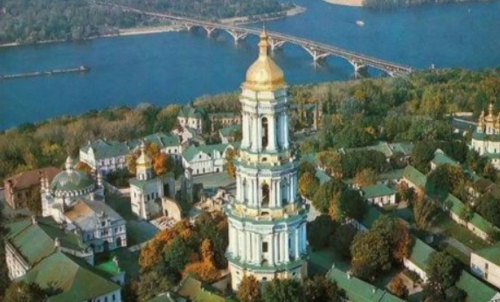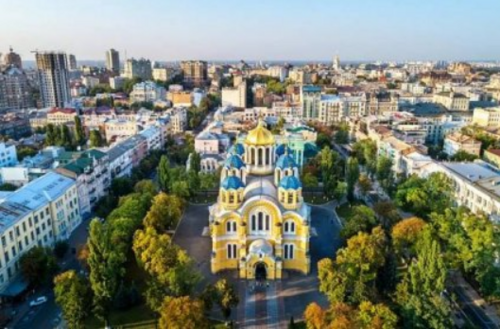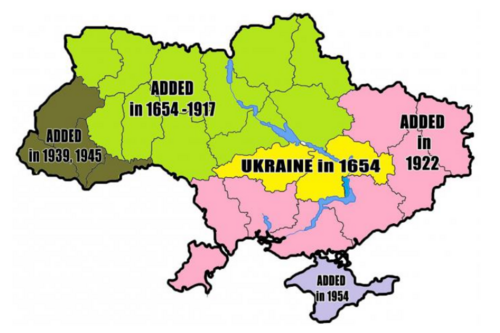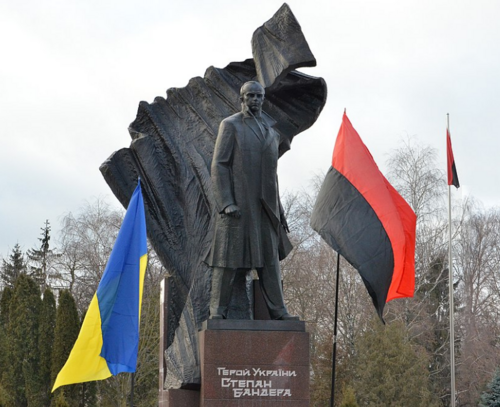

Modern history of Ukraine - overview
First of all I have to explain that the history especially of the 20th Century in Ukraine and until today is quite complicated. Though - after the European part of Russia - it is now the second largest state in Europe the history is characterised by two important facts - if simplified a bit - for long time it was split between Austrian-Hungarian empire and tsarist Russia.
During the 18. and 19th centuries and at the end of the 19th century, there was a definite collapse of Turkish power in the south, and Ukraine was already fully incorporated as one of the gubernias into the Russian empire. But tsarist Russia did not bring only national oppression and exploitation, as is often the tradition. During the reign of Catherine II the great, for example, the foundations of several now important cities were laid, such as Odessa, Sevastopol or Simferopol.
As elsewhere in Europe, the 19th century saw the rise of the revival movement and the gradual flowering of industry and transport.
 Kiev - St.Volodymyr church
Kiev - St.Volodymyr church
20th century in history of Ukraine
==========================
Ukraine as an independent state was formed on 25. December 1917, about a month after the Bolshevik revolution. The attack on the Winter Palace in St.Petersburg and the subsequent murder of the tsar's family ended the history of tsarist Russia and launched a new state grouping. To the Union of Soviet Socialist Republics Ukraine joined the 30. December 1922. To understand other contexts, it is necessary to mention the pedological circumstances of Ukraine.
By the end of the first World War and during the Russian civil war, several Ukrainian governments were assembled on part of Ukrainian territory. The first Ukrainian republic - the Ukrainian people's Republic (UNR) - existed in 1917-1919, in the eastern part of present-day Ukraine. However, it was practically only a warring party in the framework of the Russian civil war and perished under the onslaught of the Russian Bolsheviks. The people's Republic of West Ukraine (ZUNR) existed in 1918-1919 and throughout its short existence fought against Polish troops and died out under the onslaught of polish and Romanian soldiers. The two parts connected briefly on the 22nd. January 1919 (Act of Zluky).
Most of the ukrainian territory is known for having the best quality of soil for agriculture.The local quality chernozem (black soil) is so fertile that the Ukrainians produced significant surpluses of grain. This can not be said about the vast expanses of the former USSR (from Siberia to the Caucasus). Thus, Ukraine in terms of food (not only grain, but also meat) has become extremely important for Moscow. In the early days of the USSR, Stalin also carried out a purge not only in political and military circles, but also among scientists. Biologists and botanists working on possible grain cultivars that could grow even in the worse climatic conditions of the north were replaced by charlatans, making the fertile belt of chernozem running through Ukraine even more important.
The export of food from Ukraine was ordered in such large batches that special detachments had to be called up to protect Grain trains. The confiscation of food, including seeds for the next year, has begun. This meant that there would be a famine just because there would be no grain to be born from.
Holodomor literally translated from Ukrainian means "death by hunger", "killing by hunger, killing by starvation"The famine affected the Ukrainian SSR as well as the Moldavian Autonomous Soviet Socialist Republic (a part of the Ukrainian SSR at the time) in spring 1932, continued in 1933. A United Nations joint statement signed by 25 countries in 2003 declared that 7–10 million perished.
Second World War
This period of Ukrainian history is especially difficult to explain. During the fight of Soviet Union against Hitler country was divided in more parts. Here the overview:
In the years of the Great Patriotic War, Ukraine came under the administration of five formations: Transcarpathia fell to Hungary, Bessarabia and Northern Bukovina in 1940 to the Soviet Union, and the following year to Romania, which also appropriated the territory between the Dniester and the Southern Bug, creating the Transnistria province with the capital Odessa, while Galicia became part of the general Krakow as a metropolis. From the central, northern and north-eastern regions and from the southern part of the Byelorussian Soviet Socialist Republic, the Reich commissariat Ukraine was formed, controlled by the brutal and completely deaf to the needs and desires of Ukrainians by Erich Koch. The administrative center of this department was Rivno (in our country formerly known as Rivne).
Even before the WWII the history of this territory was extremely complicated. The USSR liberates the current territory of the Westernukraine in 1939, having previously captured Poland in 1918 and 1920. In 1940, in response to the demand of the USSR, Romania returns the territories of Bessarabia and Bukovina captured in 1918. Transcarpathia was liberated in 1945, and also became part of the USSR.
So, thanks to Tsarist Russia and the redistribution of the borders of the USSR after the first and second world wars, a new historical map of Ukraine was created within the current borders.

How Ukraine was formed during history
This division of Ukrainian territory is also reflected in the complicated development during the Second World War. This led to some of the most tragic events of the Second World War, the memory of which, of course, is still alive today and plays a role in European history.
From Wikipedia:
The massacres of Poles in Volhynia and Eastern Galicia (Polish: rzeź wołyńska, literally: Volhynian slaughter; Ukrainian: Волинська трагедія, Volyn tragedy), were carried out in German-occupied Poland by the Ukrainian Insurgent Army, or the UPA, with the support of parts of the local Ukrainian population against the Polish minority in Volhynia, Eastern Galicia, parts of Polesia and Lublin region from 1943 to 1945. The peak of the massacres took place in July and August 1943. Most of the victims were women and children. Many of the Polish victims regardless of age or gender were tortured before being killed; some of the methods included rape, dismemberment or immolation, among others.The UPA's actions resulted in between 50,000 and 100,000 deaths.
The Ukrainian Insurgent Army (Ukrainian: Українська повстанська армія, УПА, Ukrayins'ka Povstans'ka Armiya, abbreviated UPA) was a Ukrainian nationalist paramilitary and later partisan formation. During World War II, it was engaged in guerrilla warfare against the Soviet Union, the Polish Underground State, Communist Poland, and Nazi Germany. It was established by the Organization of Ukrainian Nationalists. The insurgent army arose out of separate militant formations of the Organization of Ukrainian Nationalists — Bandera faction (the OUN-B), other militant national-patriotic formations, some former defectors of the Ukrainian Auxiliary Police, mobilization of local populations and others.[
Stepan Andriyovych Bandera (Ukrainian: Степан Андрійович Бандера, Polish: Stepan Andrijowycz Bandera; 1 January 1909 – 15 October 1959) was a Ukrainian politician and theorist of the militant wing of the far-right Organization of Ukrainian Nationalists and a leader and ideologist of Ukrainian ultranationalists known for his involvement in terrorist activities.
 Inscription on the monument - Hero of Ukraine Stepan Bandera
Inscription on the monument - Hero of Ukraine Stepan Bandera
Stepan Bandera remains a highly controversial figure in Ukraine, with some Ukrainians hailing him as a liberator who fought against the Soviet, Polish and the Nazi's states while trying to establish an independent Ukraine, while other Ukrainians as well as Poland and Russia condemn him as a fascist and a war criminal who was, together with his followers, largely responsible for the massacres of Polish civilians and partially for the Holocaust in Ukraine.
The newest chapter of Ukrainian history
On 24 August 1991 the Ukrainian parliament adopted the Act of Independence.
In April 2015, the Ukrainian parliament passed a law that granted Bandera and some members of the OUN and UPA the status of fighters for freedom of Ukraine. Ukrainian President Petro Poroshenko called UPA fighters " an example of heroism and patriotism in Ukraine.“
In July 2016, the Moscow Avenue in Kiev was renamed Banderova.
Another chapter in Ukrainian history happened in 2014. On 18 March 2014, Russia and the self-proclaimed Republic of Crimea signed a treaty of accession of the Republic of Crimea and Sevastopol in the Russian Federation.
In this year 2014 in fact started the biggest problems splitting Ukraine and continuing in the situation today when Russian army entered the territory of this state. This is another very complicated part of the events of the last years.
If we consider the main historical events in this territory, it becomes clear that it is still divided in its views and ideas about the future direction of the country. The root of this division is deep in the minds of the inhabitants ....
Margaret
